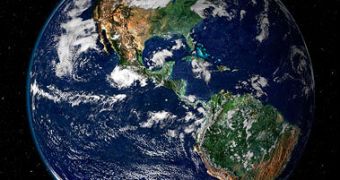A new paper published in the journal Science Express yesterday, September 5, details the discovery of several so-called fingers of heat under the Earth's surface, in our planet's upper mantle.
Scientists at the University of Maryland explain that these “fingers” were identified and mapped with the help of seismic waves.
They say that, whenever an earthquake strikes, seismic waves are created. These waves of energy travel over long distances below the Earth's surface.
Thus, as one previous research has shown, seismic waves that came into being in the aftermath of a M9.0 earthquake that hit Japan back in 2011 made it all the way to Norway, and caused waves to form in some of these country's fjords.
As they journey below our planet's surface, these waves pass through layers that differ in terms of density and elasticity. Hence the fact that they get altered.
By recording and analyzing these changes in the shape of various seismic waves, researchers are able to figure out what structures sit below the Earth's surface.
It was such information concerning the movement of seismic waves hundreds of miles below the sea floor that allowed a team of scientists led by researcher Scott French to pin-down finger-like channels whose temperature appears to be significantly hotter than that of their surrounding material.
The channels are said to be located some 120 – 220 miles (193 – 354 kilometers) below the Earth's surface. Some of these channels are as much as 700 miles (1,126 kilometers) wide, and stretch over thousands of miles.
The researchers explain that, according to their investigations, seismic waves that move through them are about 4% slower than waves passing through the channels' surrounding material.
“We estimate that the slowdown we're seeing could represent a temperature increase of up to 200 degrees Celsius (390 degrees Fahrenheit),” scientists Scott French explains.
The discovery of these channels is believed to explain volcanic hotspots such as the Hawaiian Islands chain.
Researchers say that, whereas most volcanoes form at collision zones between tectonic plates, hotspot volcanoes rise smack in the middle of one tectonic plate or the other.
Researchers theorize that, in some cases, these “fingers” of heat aid the formation of such volcanoes by influencing the way in which plume originating deep in the Earth moves and reaches out towards the surface.
“This global pattern of finger-like structures that we’re seeing, which has not been documented before, appears to reflect interactions between the upwelling plumes and the motion of the overlying plates,” seismologist Vedran Lekic argues.
“The exact nature of those interactions will need further study, but we now have a clearer picture that can help us understand the 'plumbing' of Earth’s mantle responsible for hotspot volcano islands like Tahiti, Reunion and Samoa,” researcher Scott French adds.

 14 DAY TRIAL //
14 DAY TRIAL //